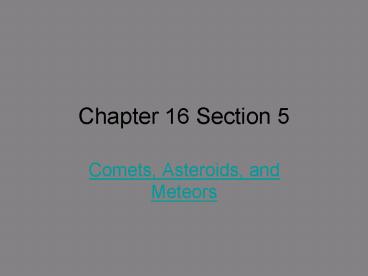Chapter 16 Section 5 - PowerPoint PPT Presentation
Title:
Chapter 16 Section 5
Description:
Nucleus center solid part of the comet Coma fuzzy cloud of vaporized gases around the nucleus Tail stream of dust and gases; ... – PowerPoint PPT presentation
Number of Views:48
Avg rating:3.0/5.0
Title: Chapter 16 Section 5
1
Chapter 16 Section 5
- Comets, Asteroids, and Meteors
2
Ch16 S5 Essential Questions
- What are the characteristics of comets?
- Where are most asteroids found?
- 3. What are meteoroids and how do they form?
3
(No Transcript)
4
Comets
- Farther our in space, near the edge of the solar
system a huge cloud formed. - This cloud is believed by some astronomers to be
the home of comets.
5
Minor Members of the Solar System
- A comet orbits the sun. A comet is made up of
ice, dust, and small rocky particles. You can
think of a comet as a dirty snowball. - Comets are small bodies made of rocky and
metallic pieces held together by frozen gases.
Comets generally revolve about the sun in
elongated orbits. - Comets are loose collections of ice, dust, and
small rocky particles whose orbits are usually
very long, narrow ellipses.
6
Minor Members of the Solar System
? Coma
The brightest part of a comet is the head. A
comets head is made up of a nucleus and a coma.
The nucleus is the solid core of a comet. The
coma is a fuzzy outer layer made up of clouds of
gas and dust.
A small glowing nucleus with a diameter of
only a few kilometers can sometimes be detected
within a coma. As comets approach the sun, some,
but not all, develop a tail that extends for
millions of kilometers.
7
Minor Members of the Solar System
? Kuiper Belt
Like the asteroids in the inner solar system,
most Kuiper belt comets move in nearly circular
orbits that lie roughly in the same plane as the
planets.
? Oort Cloud
Comets with long orbital periods appear to be
distributed in all directions from the sun,
forming a spherical shell around the solar system
called the Oort cloud.
8
Minor Members of the Solar System
? Halleys Comet
The most famous short-period comet is Halleys
comet. Its orbital period is 76 years.
9
Comets Tail Points Away from the Sun
10
Asteroid Belt
- Most asteroids revolve around the sun between the
orbits of Mars and Jupiter. - An asteroid is a rocky object that orbits the
sun. Asteroids are too small to be planets. - Most asteroids are in orbit between Mars and
Jupiter. This region of the solar system is
called the asteroid belt. - They have orbital periods of three to six years.
11
- Most asteroids are less than 1 kilometer in
diameter. Some are much larger. - Scientists think that asteroids are leftover
pieces of rock from the early solar system.
12
Irregular Orbits of Asteroids
13
Meteors
- Meteoroids come from comets or asteroids.
- A meteoroid is a chunk of rock or dust in space.
- Some meteoroids form when asteroids crash into
each other. Other meteoroids form when comets
break apart.
14
- Meteoroids can enter Earths atmosphere. When one
does, friction between the meteoroid and the air
produces a streak of light in the sky. A meteor
is a streak of light in the night sky produced by
a meteoroid. (popularly called a shooting star) - Most meteoroids burn up completely in Earths
atmosphere. However, some hit Earths surface.
Meteoroids that hit Earths surface are called
meteorites.
15
Minor Members of the Solar System
- Most meteoroids originate from any one of the
following three sources - interplanetary debris that was not
gravitationally swept up by the planets during
the formation of the solar system, - material from the asteroid belt, or
- the solid remains of comets that once traveled
near Earths orbit.
16
Major Meteor Showers
17
Ch16 S5 Essential Questions
video
- What are the characteristics of comets?
- Like a dirty snowball.
- Nucleus center solid part of the comet
- Coma fuzzy cloud of vaporized gases around the
nucleus - Tail stream of dust and gases always points
away from sun - Where are most asteroids found?
- Between the orbits of Mars and Jupiter in the
asteroid belt - What are meteoroids and how do they form?
- A chunk of rock or dust in space
- Form when asteroids collide in space or when
comets break apart































